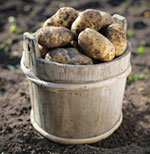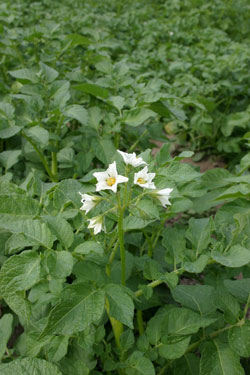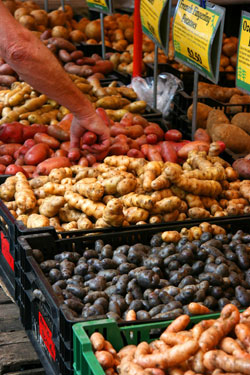|

International Year of the Potato, 2008
Because of the ease and efficiency of production, and
the superior nutritional qualities, the humble potato is
humankind’s best hope for, resolving the current
worldwide epidemic of obesity, diabetes, heart disease,
and cancer, and eventually, thriving in the near future.
The potato plant produces more nutritious food, quicker,
on less land, and in harsher climates than any other
major crop. For these reasons potatoes are the world’s
fourth most important food source after rice, wheat, and
corn.* With climate changes brought on by global
warming, the potato will soon become the world’s most
important crop. Historically, this common vegetable has
gained a well-deserved reputation for protecting
populations from starvation and improving the lives of
ordinary people.
|
 |
 According
to the FAO (Food and Agriculture Organization of
the United Nations): According
to the FAO (Food and Agriculture Organization of
the United Nations):
“The International
Year of the Potato (2008) aims at raising global
awareness of the potato's key role in
agriculture, the economy and world food
security. Celebration of the International Year
of the Potato (IYP) will raise awareness of the
importance of the potato - and of agriculture in
general - in addressing issues of global
concern, including hunger, poverty and threats
to the environment.” |
The
potato is produced in 130 nations (more nations than any
other crop, except corn). Potatoes can be grown at
almost any elevation and in most climates. Although it
originated in the cold, dry Lake Titicaca region of Peru
and Bolivia (elevation 12,500 feet) between 7,000 to
10,000 years ago, the potato thrives in wet, warm costal
areas. The potato plant requires very little water,
matures in as little time as 50 days, and can produce
four times more food on the same amount of land, than
can wheat or rice. One acre of potatoes can feed 10
people for a year. After being harvested from the
ground the potato can be stored for six months or more
under cool, dry, well-vented conditions—thus providing
food all year long. Although it
originated in the cold, dry Lake Titicaca region of Peru
and Bolivia (elevation 12,500 feet) between 7,000 to
10,000 years ago, the potato thrives in wet, warm costal
areas. The potato plant requires very little water,
matures in as little time as 50 days, and can produce
four times more food on the same amount of land, than
can wheat or rice. One acre of potatoes can feed 10
people for a year. After being harvested from the
ground the potato can be stored for six months or more
under cool, dry, well-vented conditions—thus providing
food all year long.
The potato has been
regarded as poisonous, tasteless, boring, fattening,
hard to digest, and as an aphrodisiac; it has been
considered cattle- and pig-food, reserved only for times
of famine and for the poor. In truth, science and
history have consistently judged a potato-based diet
correctly: a diet ideal for supporting human health and
productivity.
 Starch is the predominant
form of carbohydrate found in potatoes. Human beings are
anatomically and physiologically designed as a
“starch-eaters.” (See my October 2007 newsletter
article, “DNA
testing proves humans are designed as starch-eaters.”)
Called by the French, “pommes de terre,” these apples of
the Earth provide ideal sources of energy, proteins,
fats, vitamins, minerals, and fiber. Their abundant
proteins easily provide all of the essential amino acids
required for healthy adults and children. They are
anti-scurvy (Vitamin C) and excellent sources of all
vitamins and minerals (except B12). Potatoes are a
complete food: People can and have lived for extended
periods on potatoes
as their sole source of nourishment. (For more
information on how potatoes keep people trim and healthy
see my April 2002 newsletter article: “Potatoes
Are the Pillars of Worldwide Nutrition.” Starch is the predominant
form of carbohydrate found in potatoes. Human beings are
anatomically and physiologically designed as a
“starch-eaters.” (See my October 2007 newsletter
article, “DNA
testing proves humans are designed as starch-eaters.”)
Called by the French, “pommes de terre,” these apples of
the Earth provide ideal sources of energy, proteins,
fats, vitamins, minerals, and fiber. Their abundant
proteins easily provide all of the essential amino acids
required for healthy adults and children. They are
anti-scurvy (Vitamin C) and excellent sources of all
vitamins and minerals (except B12). Potatoes are a
complete food: People can and have lived for extended
periods on potatoes
as their sole source of nourishment. (For more
information on how potatoes keep people trim and healthy
see my April 2002 newsletter article: “Potatoes
Are the Pillars of Worldwide Nutrition.”
*Potatoes are consumed by
more of the world's population than any other vegetable
(in distinction to grains). Corn is mainly used
for animal feed.
A
Medicine and a Poison
The
potato is from the plant family Solanaceae. This family
also contains the tomato, peppers (capsicum), and
eggplant, along with powerful poisonous plants,
including mandrake, henbane, tobacco, and the deadly
nightshade. The most pharmacologically active compounds
found in the potato are the solanine glycoalkaloids (α-solanine
and α-chaconine). Their primary purpose is to defend the
potato plant against bacteria, fungi, viruses, insects,
animals, and humans. However, at appropriate levels
these glycoalkaloids have medicinal effects for people.
|
Known Medical
Benefits from Extracts of Solanine |
|
Lowers
cholesterol
Anti-diabetic
Anti-allergic
Anti-itching
Anti-inflammatory
Antibiotic (bacteria, fungi, parasites, viruses)
Anticancer |
Like
most medicines, solanine can become poisonous when
delivered in high concentrations. Farmers have known for
centuries that potatoes could poison their cattle and
pigs. The highest concentrations of glycoalkaloids occur
just under the skin and in areas of high metabolic
activity, such as the eyes. Hence peeling potatoes
reduces their toxic potential. The glycoalkaloid levels
in the plant’s parts increase with age and exposure to
light.
In
people, the clinical effects are due primarily to their
anti-cholinesterase activity, and include headache,
diarrhea, nausea, vomiting, weakness, depression, and
finally paralysis. A rare skin disease called ‘potato
eruption’ begins as red papules that can progress to
pustular crusted lesions. Death from solanine poisoning
from potatoes is rare. These chemicals are resistant to
cooking and may stay in the body for several days. To
eliminate the risks, do not eat spoiled potatoes; which
usually means those potatoes with green discoloration
under their skin and/or sprouted potatoes, having
“growing eyes.”
The
Versatile and Enduring Potato
For
millennium, the five thousand potato varieties found
worldwide have been consumed fresh (boiled or roasted)
or reconstituted in stews from dried forms. Potatoes are
outgrowths (enlargements) of the roots of the potato
plant—called tubers. The primary purpose of the tuber is
to store energy to keep the potato plant alive during
the winter months and through droughts. Secondarily,
these
starch-rich,
underground storage organs (USO)
benefit us by providing a high energy, nutritionally
complete food for people, during times of feast and
famine.
|
Common Methods of
Serving Potatoes: |
|
Mashed
Baked
Roasted
Boiled
Steamed
Microwave
Hash Browns
Potato Pancakes
French Fries
Potato Chips
Potatoes need no sophisticated equipment for
cooking. |
 |
|
Common
Potato Types: |
|
Russet potatoes
(the classic potato; also called Burbank and
Idaho) are long, slightly rounded and have a
brown, rough skin and numerous eyes. Excellent
for baking and for French fries.
Irish potatoes
are waxy, and ideally suited to boiling, as they
will hold their shape well. They can also be
roasted, broiled, or turned into potato salads
and fried potatoes.
Yukon Gold potatoes
are roughly spherical in shape, with dull brown
to gold skin, and are usually waxy. They are
delicious in soups and make excellent mashed
potatoes.
Red Bliss potatoes
have a red flaky skin with a white flesh.
Round Red potatoes
are waxy boiling potatoes with smooth skins.
Peruvian Purple potatoes
have dark purple skins and pale purple flesh.
Fingerling potatoes
naturally grow much smaller than conventional
potatoes, and are elongated and slightly
knobby—thus, finger-like in shape. They are
roasted, broiled, baked, grilled, or boiled.
New potatoes
are potatoes that have not fully matured.
Chip potatoes
(Atlantic and Snowden) are grown
especially for potato chip production and not
available in the supermarkets. |
Preserving Potatoes
The
single disadvantage of the potato, compared to wheat and
corn, is they cannot be stored and carried over from
year to year in their harvested form because the tubers
rot. Fortunately, various drying methods will preserve
them as future food. Since ancient times, people of the
Andes would “freeze-dry” potatoes. The process involved
freezing, trampling by foot to remove some water and
skins, and then refreezing in the cold night air. This
product, known as
chuño,
would last in good condition for 10 years when stored in
a dry, sealed room. Another traditional product is
papa seca ("dehydrated potato"). The tubers are
boiled, peeled, cut into chunks, sun-dried, and then
ground into a starchy staple that is often eaten with
tomatoes, and onions. These days, papa seca is
consumed more widely than chuño and can be
purchased in supermarkets. Sun-drying potatoes is a
cottage business in India and Asian countries—this new
growth industry provides an inexpensive way to preserve
potatoes and to smooth out seasonal gluts.
|
You can order
dried potatoes in bulk: |
|
North
Bay Trading Co.
Harmony House Foods
The manufacturer states they will
last about 2 years. However, with proper storage
in a cool dry place, they will last much longer. |
You
may want to start your own “victory garden” to offset
your food expenses and prepare for a future where the
potato will be your most reliable food source. You-Tube
has instructional videos on how to grow and harvest
potatoes.
The
Anti-famine Food
Adoption of a potato-based agriculture is credited with
the virtual elimination of famine in Europe by the early
nineteenth century. As a testament to the capacity of
the potato to support people, between 1801 and 1851, the
populations of England and Wales doubled to almost 18
million people, and the Irish population was able to
double to eight million between 1780 and 1841 as a
direct result of the widespread cultivation of the
potato. Fortunately, the common potato is now being
rediscovered as a nutritious crop, producing a delicious
food, which will cheaply feed an increasingly hungry
world. This enlightenment has the potential to save the
human race from starvation, as it has done for so many
communities in the past. The United Nations has
declared 2008 the “International Year of the Potato,” and for good
reason: to raise “global awareness of the potato's key
role in agriculture, the economy and world food
security.”
References:
Lee MR. The Solanaceae: foods and poisons.
J R Coll Physicians
Edinb. 2006
Jun;36(2):162-9.
Friedman M. Potato
glycoalkaloids and metabolites: roles in the plant and
in the diet.
J Agric Food Chem.
2006 Nov 15;54(23):8655-81. |